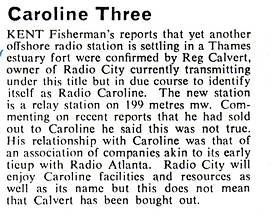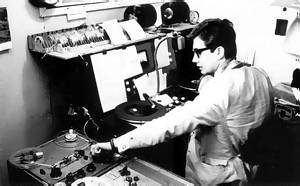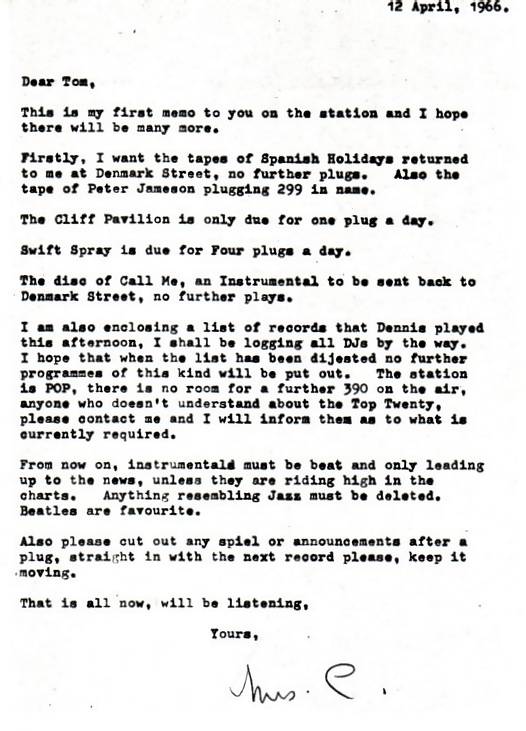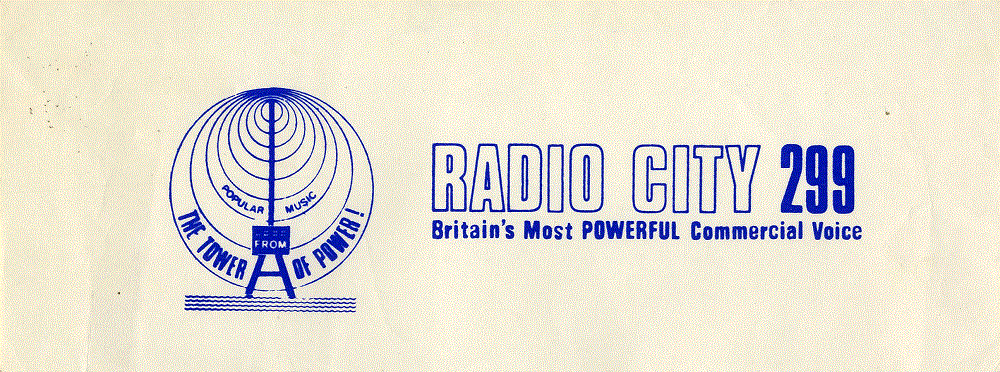|
|

|
|
Trade paper ‘TV Mail’ reports the tie-up between Caroline and City. Cutting courtesy of Hans Knot.
|
In September 1965 merger talks began between Radio City and Radio Caroline South. The ship-borne station was losing both listeners and revenue to the bigger, more powerful, more professional
Radio London. As the fort was considerably cheaper to operate, it was proposed that Shivering Sands should become the base for Caroline South. Project Atlanta, which owned and operated the Caroline South ship, sent
a transmitter out to the fort for use by the new station. This piece of equipment was later to be the cause of a dispute which resulted in a raid on the fort and the death of Reg Calvert.
As these negotiations were getting underway, Radio City took over the Knock John fort off Southend. (See Cliff Cuttelle's photo album.) The official reason for this occupation was that Knock
John was to be used as a test-bed for new equipment but, obviously, if Shivering Sands was now to be used by Caroline, Reg Calvert was looking around for a new home for his station. However, it was not going to be
here.
Southend businessman Roy Bates had plans to start his own station, Radio Essex, on the same fort and a feud developed between the two groups of pirates. Knock John repeatedly changed hands, with each side kidnapping
the other's men, and, although it never actually got violent, some threatening incidents took place out at sea. Fortunately, before it went too far, an agreement was reached between the two groups. Radio City got
its equipment back and Roy Bates got to keep the fort. Radio Essex started broadcasting from there in October. (See press cutting).
|

|
|
Tom Edwards in the Radio City studio. Photo taken by Martin Stevens and kindly provided by George Morris.
|
Tom Edwards remembers his time on Radio City with great affection:
“Reg Calvert hired me some time in 1965 and at once took a shine to me, as did the whole of his family - Mrs. Calvert plus Candy
and Susan the daughters.
When I first arrived at the towers I was amazed at the size of them, then being hoisted up 90 feet above sea level! I hated getting on and off the blasted things in all my time there. Chris
Cross was senior DJ at the time, plus Alex Dee. Paul Kramer came along later as did Adrian Love, Ian
MacRae and Alan Clark, Dennis Straney aka Dennis the Menace (which he was!) and RWB.
I was a young man of 22 and it was an exciting time. I also made friends on shore in Whitstable and eventually set up home with Phil Perkins who was a City engineer. A lovely place right
on the seafront with Peter Cushing the actor as a neighbour.
I recall a few members of the City staff wanting to form some kind of company and when Reg heard of this he went into one of his terrifying rages. He sacked almost everyone on the spot and appointed me as Chief DJ and
Programme Director there and then. Later of course I firmly believe it was Reg's temper that caused his death.
|

|
|
The first of many memos about station programming sent to Tom Edwards by Mrs. Calvert. Click to magnify. Kindly donated by Hans Knot.
|
I wanted to ‘upgrade’ the sound of Radio City and thought we must have a news service, which we did - gathering stories from the BBC Light programme and World Service.
I rejigged the stories and thought no one would ever suss what we were up too.
Ian and Alan formed The Auntie Mabel Hour which was way way ahead of its time ... very very funny and inventive. We also had The Five by Four Show each weekday with nothing but the Beatles and Rolling
Stones music. Hundreds of requests poured in with every visit from (the tender) Harvester II, always ably supplied by Freddie Downs the skipper.
I also got Reg to fork out for a proper studio clock and we did have the most accurate timechecks of all the pirates. I would set the second hand to the BBC's ‘pips’.
Reg wanted his groups, The Fortunes and Pinkertons Assorted Colours, played on a regular basis - and why not - it was his station after all.
What actually paid our wages, and the running of Radio City really, was the American religious programmes such as The Voice of Prophecy and the unforgettable A.A Allen Revival Hour. The way Allen shouted
used to overload the compressor and sometimes take us off the air. Oh what fun!
With the music, I would sit and sift through all the many singles sent out. I got well known ‘names’ to say they listened to City. I knew by instinct that Sinatra's Strangers in the Night would be a
number one. All the guys thought I was nuts. Well I wasn't. And also Frank's daughter Nancy I knew would have a hit with These Boots Are Made For Walkin'. My favourite, which still makes me think of those far
off days, is Fontella Bass and Rescue Me. Still played a lot but never made it to number one. A turntable hit in other words.”
 Tom Edwards on the air from August 1966. Recording kindly provided by Stuart Russell (duration 2 minutes 34 seconds)
Tom Edwards on the air from August 1966. Recording kindly provided by Stuart Russell (duration 2 minutes 34 seconds)
 Ian MacRae on the air from August 1966. Recording kindly provided by Stuart Russell (duration 3 minutes 12 seconds)
Ian MacRae on the air from August 1966. Recording kindly provided by Stuart Russell (duration 3 minutes 12 seconds)
 Ian MacRae and Alan Clark on the unique ‘Auntie Mabel Hour’ on Radio City. Recording kindly provided by Nick Widdows (duration 2 minutes 49 seconds)
Ian MacRae and Alan Clark on the unique ‘Auntie Mabel Hour’ on Radio City. Recording kindly provided by Nick Widdows (duration 2 minutes 49 seconds)
The merger talks with Radio Caroline South collapsed and Reg Calvert carried on the operation of Radio City on his own. At the same time he began talks with Caroline's great rival, Radio London. The
fascinating book Starmakers And Svengalis has a chapter devoted to Reg Calvert. In it author Johnny Rogan suggests
that Calvert had realised by this stage that offshore radio from a fort could not last forever and wanted to sell up while his station was at the peak of its success. Rogan also reveals that the ever-inventive Calvert
had a plan to use the money raised by selling Radio City to launch a pirate television station from a submarine!
|




